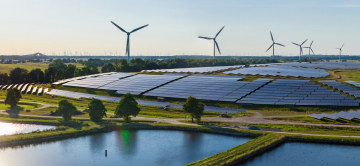European governments are risking billions of euros on a bet that hydrogen will gradually become a "clean, safe and affordable" energy carrier. But this may be wishful thinking, say TSE energy experts Claude Crampes and Stefan Ambec, unless there is a significant decline in production and distribution costs.
The energy scene’s latest star is unquestionably hydrogen. In June, Germany promised to invest €9 billion in hydrogen technologies, overshadowing the 2018 French plan and its €100 million per year. In July, the European Commission announced its strategy to produce 1 million tons of "renewable hydrogen" by 2024 by increasing the existing 1GW fleet of electrolyzers, mainly powered by coal or natural gas, to at least 6GW using renewable energies. From 2024 to 2030, its target is 10 million tons with 40GW of capacity.
The 2020 French recovery plan (Relance France) will invest €2 billion in the hydrogen sector over the next two years, and €7 billion by 2030. Demand will be supported by guaranteed repurchase prices similar to those enjoyed by wind and solar producers, a mechanism that has proven costly but effective for developing production facilities and reducing the cost of these energy sources.
These programs have several objectives: (i) Decarbonize production for industries such as oil refining and fertilizer production that cannot do without hydrogen; (ii) Extend uses to transport, construction, electricity production and manufacturing; (iii) Develop world leadership in the sector. But won't all these billions leak through the holes in a new Danaïdes' barrel?
Counting the costs
More than 90% of industrial hydrogen is currently produced by chemical extraction of fossil hydrocarbons, thus emitting greenhouse gases. Hydrogen can also be obtained by electrolysis of water, but the cleanliness of this process depends on the energy used.
Hydrogen has a wide range of uses but distribution costs are high. It corrodes alloys, which can lead to catastrophic failures. It is very bulky in its gaseous state and has very little energy power, so it has to be compressed or liquefied (at -252°C), then distributed and retransformed into usable energy. The efficiency of converting electricity to hydrogen and back to electricity is very low: today, it takes almost 5kWh injected to recover 1kWh.
Renewable hydrogen (2.5-5.5€/kg) is currently not competitive with hydrogen produced using fossil fuels (about 1.5€/kg, excluding the cost of CO2). Even adding carbon capture and sequestration, the latter comes to about 2€/kg. Green hydrogen optimists point to the cost of electrolyzers, which has fallen by 60% over the past decade. The European Commission predicts that economies of scale will cut the cost by a further 50% by 2030.
Hydrogen vs batteries
Storage: To make electricity/hydrogen double conversion profitable, high-price sales and low-price purchases are needed to cover installation and maintenance costs. On a daily cycle, it can be profitable to meet high peaks in the morning and evening. But longer-term storage in tanks is where hydrogen can outperform batteries as part of the solutions required for a 100% renewable electricity mix.
Transport: The windiest or sunniest places are not necessarily the most populated. Hydrogen and hydrogen-based fuels could make it possible to transport renewable energy over thousands of kilometers between production locations (with low prices) and consumption locations (with high prices). But again, the costs of installing and maintaining infrastructure, together with losses from transmission and double conversion, are higher than those of high-voltage line construction.
Fuel: Whether they use internal combustion or an electric motor connected to a fuel cell, hydrogen engines produce energy and water by combining hydrogen with oxygen from the air. The cleanliness of this conversion is ideal for urban transport. The big advantage of hydrogen over "all-battery" electric vehicles is the speed of recharging. The disadvantage is the much greater volume and weight of the tank, compared to gasoline and diesel.
High stakes
Electrolyzers are one thing, their use of green electricity is another. The above plans seem to overlook the necessary investments in wind and solar power to separate hydrogen and oxygen, in storage and distribution, and in conversion equipment at consumption points. In France, the supply of nuclear energy to electrolyzers is a decarbonated solution, although certainly not 'green'. But in the long term, the multiplication of renewable production units will create tensions over the occupation of space, both on land and offshore.
After supporting renewable energies and electric cars, Germany and France are betting on hydrogen to reconcile decarbonization and technical progress. This is a costly and risky gamble. One of the gains would be technological leadership on an essential energy resource, provided that guaranteed purchase prices do not encourage the development of a low-cost sector outside Europe. But the climate emergency also requires emerging countries to rapidly move away from fossil fuels, and therefore a wide dissemination of decarbonated technologies.
TSE Mag #21 Winter 2021
Illustration Bill Oxford on Unsplash





